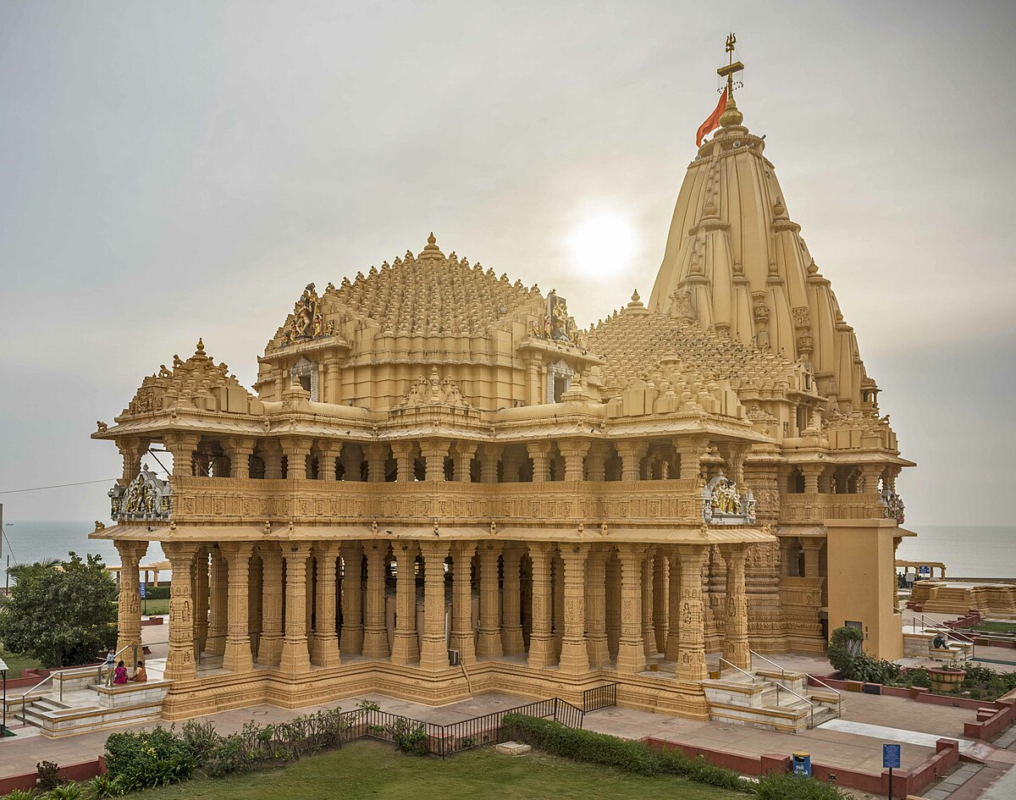Somnath Temple Story: The land of India has been a living symbol of Sanatan culture and divinity. There are 12 Jyotirlingas of Lord Shiva established at different places on the land of India, where every year devotees reach in large numbers to get the darshan of Bholenath.
Jyotirlinga is considered to be a symbol of the radiant and conscious forms of Lord Shankar. Among all these, Somnath Temple (Somnath Jyotirlinga) has the status of the first Jyotirlinga, which is also mentioned in Koti Rudra Samhita of Shivpuran. Today we will shed light on the origin of Somnath Jyotirlinga, its mythological importance and the amazing story associated with it (Somnath Temple Story).
Table of Contents
What is Jyotirlinga?
The word ‘Jyotirlinga’ is made up of two parts – Jyoti i.e. light and Linga i.e. the symbolic form of Lord Shiva hence Jyotirlinga is such a Shivling in which Shiva himself is revered in the form of fire or light. According to the Puranas, when Brahma and Vishnu had a dispute over superiority, Lord Shiva appeared in the form of a huge pillar of fire and made them realize his infinity. Jyotirlingas were established at 12 places as a symbol of that divine pillar.
Where is Somnath Temple located?
Somnath Jyotirlinga is located in the Saurashtra region of Gujarat state of India, at a holy pilgrimage place called Prabhas Patan. This place is situated on the banks of the Arabian Sea and is very important not only from religious but also from historical point of view. Devotees come to visit this Jyotirlinga not only from Gujarat but also from every corner of India.
Read our article to see the names and places of 12 Jyotirlingas of India.
Somnath Temple Story
The story of Somnath is associated with Chandradev (Moon God) and Daksha Prajapati. Daksha Prajapati, who was born from the thumb of Lord Brahma’s right hand, got his 27 daughters married to Chandra Dev. But Chandra’s 26 queens were upset when they saw that their husbands spend more time with their sister Rohini.
Hurt by this discrimination, the other daughters returned to their father Daksha. Daksha tried to explain to Chandra Dev that Chandra Dev, you have been born in a high family, it does not suit you to ignore your other wives in this way and love my daughter Rohini more, so I request you to treat all your wives equally.
Since Daksha was the Prajapati of the entire universe, he thought that Chandra Dev would agree to his words, but Chandra Dev did not change his habit.

When Daksha’s daughters went back to their father with a complaint, Daksha got angry and cursed Chandra. Daksha said that the beauty and light of which you are so proud will fade away and you will gradually fade away and disappear. When this started happening the powers of the demons started to prevail and all the gods got worried. They sought guidance from Brahma Ji. Brahma Ji advised them to go to Prabhas Tirtha and worship Lord Shiva with the Mahamrityunjaya mantra.
After this, Chandradev and all his wives did rigorous penance for six months. They made a Shivling of clay, started anointing it continuously and chanted the Mahamrityunjaya mantra 10 crore times. Finally, Lord Shiva was pleased with Chandra’s devotion and blessed Chandradev that though your brightness will be taken away, but after some time that brightness will start coming back and in this way every day one part of you will remain bright and the other will remain in darkness. This is the same incident related to the moon which gave rise to the full moon and new moon.
Lord Shiva incarnated himself in that Shivling and that place came to be known as Somnath Jyotirlinga. The glory of this Somnath Jyotirlinga situated in the holy Prabhas Kshetra has been described in detail in Mahabharata, Shrimad Bhagwat and Skanda Purana. One of the names of the moon is Som, it did penance here considering Lord Shiva as its Nath-Swami.
Hence, this Jyotirlinga is called Somnath. By seeing, worshipping and praying to it, all the sins and misdeeds of the devotees of many births are destroyed. They become the recipient of the eternal grace of Lord Shiva and Mother Parvati. The path of salvation becomes easily accessible for them. All their mundane and supernatural acts become successful automatically.
Repeated reconstruction of Somnath Temple
The Somnath temple does not only have religious significance, but it is also a symbol of Indian faith and self-confidence. This temple is divided into three major parts – sanctum sanctorum, assembly hall and dance hall. It has a 150 feet high peak. The urn on its peak weighs ten tons and its flag is 27 feet high.

It has been attacked 17 times in history. From Mahmud Ghazni to Alauddin Khilji, Aurangzeb, many invaders destroyed it, but every time the Indian people re-established it.
This temple was last rebuilt after independence with the efforts of India’s Iron Man Sardar Vallabhbhai Patel. At present, this temple is a symbol of Indian cultural pride.
Right time to visit Somnath
The months from September to March are the best to visit Somnath Temple because it is winter season at this time. However, due to peak season, tourists also come here the most at this time and hotels are also very expensive. If you want to avoid the crowd and tourists coming to Somnath, then you can enjoy visiting here during summer and monsoon season. Due to summer and monsoon, you will find less crowd at this time and hotels are also available at cheaper prices.
But whenever you go, try to have darshan as early as possible in the morning because if you go after 9-10 am, you will have to stand in line and darshan may take more than 2 hours.
To know the time of darshan of Somnath Temple and what will be the best way to reach the temple, see our article.







